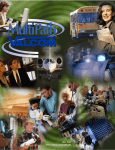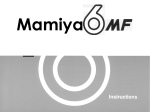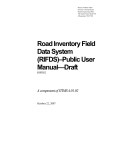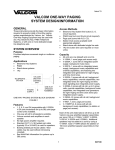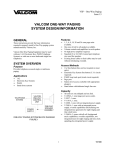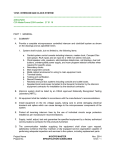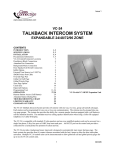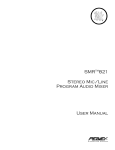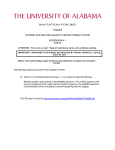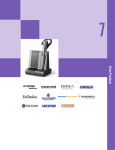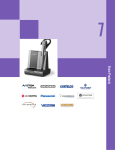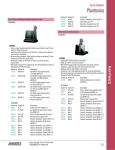Download Dual XPR522 Technical information
Transcript
Distribution Version Don’t lose your system warranty! System warranty requires registration of all cards. Registration is free and easy via the World Wide Web at http://www.valcom.com/register. Revised May 15, 2006 Content Writing a proposal (3) Some Tips for Successful Bids (11) Cost Effective Speaker Choices (14) Commonly overlooked items: Valcom MultiPath Systems (15) Other important considerations (17) AC Power (17) Environment (17) Existing Call Switches (17) New Call Switches (17) Existing Wiring (18) Surge Protection (18) Integrating with Existing Networks (18) Sound Reinforcement Systems (18) Talkback Speakers (19) Telephone System Integration (19) Ethernet Connectivity Options (19) Telephone System Types (23) Telephone System Terms (23) Common Area Speakers (24) One Way Self Amplified Speakers (25) Main and Intermediate Distribution Frames (27) Potential Applications (29) Typical School Zone Design (33) 25-Volt Retrofit Applications (35) This document is updated on a regular basis. For the most current information, please review the latest version (available on www.valcom.com/multipath) prior to each new job proposal. Page 2 of 36 Revised May 15, 2006 Writing a proposal Quite often, business proposals provide a client’s first impression of a your business. A well written, neatly organized proposal represents your business as organized and professional. Typically, proposals are written for one of 2 reasons - responding to a Request for Proposal (RFP) which asks for a solution to a problem or; you have identified an opportunity to provide a product or service to satisfy a requirement a potential client may not even know that they need. This is usually referred to as an Unsolicited Proposal. Regardless of the situation, the steps to writing an effective proposal are the same. Here are some guidelines and tips. Cover letter Although the cover letter is generally written after you have finished all the other components of the proposal, it is the first item seen by the recipient and it forms your opportunity to gain the reader's trust and support. Your cover letter should be brief and straightforward, including what you are submitting. The same letterhead and style should be used as your company's regular letters. Take this opportunity to briefly state the main strengths of your bid. The key unique selling points that differentiate your bid from the competing bids should be emphasized. Close your cover letter on a cordial note by adding warmth and a personal touch to the letter. A good way of achieving the touch is to liberally sprinkle the letter with "I" and "you". This technique adds personality and makes a positive and personal connection between your proposal and the reviewers. This is particularly effective if you have met the reviewers at some earlier stage. Have the most senior person possible sign the cover letter, as this shows the commitment of your company to the proposal. Title page The title page is an interesting study in contrast. On the one hand it is simple and short, yet on the other hand, since it is one of the first components of your proposal that the readers see, it can be profoundly persuasive in its ability to form a strong and lasting impression. The title page has four components: the title, the name of the client or recipient of the proposal, the name of your company, and the date. Note Page 3 of 36 Revised May 15, 2006 that the name of the client is usually at the top whereas your firm is listed on or near the bottom. This indicates your client-oriented approach; that is, you are proposing to improve the client's business, not selling your service. Other information such as the client file or reference number may be included. This can be useful for large clients such as government departments who issue many RFPs. You may wish to add some simple graphics to enhance the visual appeal of the title page, however the graphics should not be so elaborate as to detract from the main message. The appearance of the proposal is a reflection of the quality of the report that you would produce. The appearance of the proposal can be a significant factor in the evaluation, especially in consulting where the final report is often the main product. For particularly large and important proposals, you should consider designing a unique cover that reflects the theme of the proposal. Proprietary Notice An optional consideration is a proprietary notice, warning the client that the information in the proposal is confidential and is to be used solely for the purpose of evaluating the proposal and is not to be disclosed to anyone outside the discussion group without your written authorization. This notice should be used when you have confidential data, innovative ideas, or other information in your proposal that you do not want falling into the hands of your competitors. It can be very frustrating to lose the bid, but have the winning consultant use your brilliant concepts in the subsequent work. A good place for the proprietary notice is on the inside of the front cover. Introduction The main purpose of the introduction is to gently lead into the subject, rather than jumping in cold. You should also use this opportunity to give the reader confidence in the service or product that you are presenting. The introduction should provide a brief summary of the background to the project in question, outlining the need for the service or product. It can also include a brief summary of what is to follow in the remainder of the proposal. You should highlight the key points that make your company suitable for providing it. The readers/evaluators of your proposal should not have to search for your unique selling points; they should stand out, guiding the reviewers to the correct conclusion-that your proposal is the Page 4 of 36 Revised May 15, 2006 best one. The introduction should be kept short and sweet; generally try to keep it less than two pages. Technical approach This section allows you to reinforce your authority as an expert by laying out a sound technical plan for the project. The technical approach must demonstrate that you understand the problem and have a methodology for resolving it. This is the time to introduce innovative ideas or solutions. Your impact will be greatly lessened if the plan is fuzzy or general in nature, as invariably happens if you haven't taken the time to thoroughly research the subject. The methodology must be described, including the resources that will be required. The more professionally you present the technical approach, the more competent you will appear and the more confidence the evaluator will have in your proposal. Brainstorming with some of your best technical experts is a useful way of giving an understanding of the problem and developing a sound methodology. Innovative approaches should be sought and any unique selling points that your team can bring to the project should be highlighted. A task must be measurable and assignable. That is, you should be able to assign a single person, the task leader, to be responsible for its execution, although other staff may also contribute to it. Each task should have a definite outcome, a budget, and duration. In other words, a task is a work element that can be assigned, have its progress monitored, and produce discreet deliverable components. If the project is at all complex, a flowchart of the technical approach will help the reader. It is a road map and should guide the reviewer through the technical network of your proposed methodology. The flowchart is often very helpful to you, as well, as its preparation forces you to analyze the logical flow and interrelationship of the technical tasks that you are proposing. A section on anticipated difficulties is generally helpful as it shows you have taken the time and interest to analyze potential problems and to think of ways of overcoming them. If the project has a particularly difficult schedule or budget to satisfy, then the effort you have invested in recognizing these obstacles and thinking about their resolution will gain the client's respect. The technical approach is generally the longest section in your proposal and should certainly be the one that consumes the deepest thought. Page 5 of 36 Revised May 15, 2006 Project team This section presents your project team to the reader. If you have subconsultants on the team, you will want to include a simple corporate team organization chart. It is generally useful to include the name of the key coordinator for each organization. The main purpose of this section is to introduce the reader to the project staff. A project organization chart is a valuable tool and shows at a glance the hierarchy that you will use and the individuals involved. For the key staff you should provide a brief capsule resume that describes the person's qualifications for this project and also the responsibilities he or she must assume. You should take the trouble to customize the capsule resumes so they specifically address the needs of the project, rather than just using your standard ones. Special emphasis should be placed on the project manager because he or she is the key technical person as well as the main conduit of communications between the project team and the client. You should strive to paint your project manager as a person who has most if not all of the following traits: authoritative in the subject under consideration, excellent verbal and written communication skills, clout within your organization, strong organizational skills, and a track record of successful projects. Relevant experience Your description of relevant experience is a vitally important part of the proposal. This section must establish the qualifications of your team and must forge a strong sense of confidence that your team has the technical and organizational expertise to perform the project. The bulk of this section should consist of capsule descriptions of relevant projects that your company has performed. Lengthier descriptions should be placed in an appendix. Magazine articles, conference papers or other publications are particularly effective in establishing your technical credentials and they should be summarized in this section. In addition, you should specify relevant equipment, facilities such as laboratories or computers, information sources such as databases, and any other factors that show you can fulfill the technical requirements of the project and/or which provide you with an advantage over your competitors. Avoid discussing your competitors' weaknesses. Instead, highlight your own strengths; a good evaluator will be able to draw the proper comparisons. Page 6 of 36 Revised May 15, 2006 In spite of the importance of this section, it should not consume a great deal of your proposal preparation time. Most of the information can be drawn directly from files of relevant project descriptions in an appropriate word processing format, which you have compiled expressly for the purpose of preparing your proposals efficiently. Project Price/Budget Your proposed price/budget is the single most important part of your proposal. Every other part of your proposal is qualitative, but the budget is quantitative and can be summarized in a single number. There are two basic kinds of price that can be proposed. The first are fixed-price contracts in which a single price is quoted. Your service will cost the client that exact amount. If you can do the work for less, then you will gain. If it costs you more, then the client will be the winner. A client often prefers this kind of contractual arrangement when there is some element of risk involved in the project. A firm price removes the risk for the client. The fixed price may be in one lump sum on completion of certain milestones, with the remainder due when the job is done. The other kind of contract, and the most common one, is where the cost of services is given a ceiling. Here you are only paid for the amount of work that you perform, up to the specified ceiling. This kind of contract is used when there is some uncertainty about how much effort is required. It offers protection to the consultant in the event the work scope is not well defined or if there are unforeseen developments. Usually, billings are made at the end of every month for the labor and expenses incurred. Regardless of the type of contract, you will need to perform a budget analysis. The client will usually want a detailed breakdown of your budget estimate. The cost for each of the following cost categories should be estimated: • • • • • • • • • Labor Outside services Travel Equipment Supplies Communications (i.e., long distance telephone, courier, fax) Sub-consultants Miscellaneous Contingency Page 7 of 36 Revised May 15, 2006 This kind of budget estimating is well suited to computer spreadsheet software. You should have a standard template for performing these cost estimates efficiently. For the labor cost, you could provide a table of the key staff, each person's hourly charge rate, and the number of hours each person will spend on the project. It is also useful to provide a table that is subdivided by task so that the total cost per task is shown. A spreadsheet is helpful for both the client and your project team as it presents costs broken down in several useful categories. The client can readily see how the resources are allocated and which tasks are receiving priority. This format is also a valuable planning aid once you win the contract. Each task leader can easily see who is assigned to the task and how many hours are allocated. Each person can also see the total hour commitment to this project and can integrate this information with the other project requirements. The fixed fee or the ceiling price should be clearly shown; under no circumstances should the reader have to search for these key numbers. It will aid the reader if there is a summary table, which lists each of the cost categories with their estimated budget. Other summary tables might also be included. If it has not been specified in the RFP, it is important that you tell your future client how you expect to be paid. The payment method depends on a number of factors such as the nature of your business, your relationship with the client, your cash-flow position, etc. One common method is to request payment on a monthly basis, with your invoice submitted shortly after the month end. Another common method of payment is based on milestones, that is, the client releases certain fractions of the payment as you reach specified milestones in the project. In some cases, when the project is of a relatively short duration, a single payment on completion of the project may be appropriate. Alternatively, if the client is a new one, or one whose credit worthiness is suspect, you may wish to collect all or some of your fees in advance. Because of the large variation in how the payment can be made, it is essential that an understanding be established in advance and that you clearly note your preference in the proposal. Your proposal should define the terms of payment that you expect and the penalty if those terms are not met. For example you might specify that your invoice is due within a certain period of its receipt, say 30 days, or you might request that payment be issued immediately upon receipt of the invoice. In either case, you may also wish to include a statement that a penalty of, say, 1-5% per month, will accrue to overdue accounts. Page 8 of 36 Revised May 15, 2006 Schedule The timetable for the project is specified in some detail in the schedule section of your proposal. One of the best ways to convey the schedule to the reader is to develop a diagram that shows: a. each task as a function of item b. the interrelationships between tasks (i.e., can task #3 begin only when task #2 has been completed or can it be done in parallel?) c. major meetings, and d. milestones. By identifying potential difficulties in the schedule and how you propose to overcome them, you are demonstrating to the client that you understand the problem. This will gain his/her confidence and trust-very important commodities-which you should relentlessly pursue. The client always has a strong interest in closely following the project to ensure that it will be completed on schedule and successfully. To help the client track your progress, you can provide him/her with a set of milestones that should be clearly marked on the schedule diagram and also described in the text of the proposal. The final date of completion of the project and the total duration should be clearly identified and should match the expectation of the client. Certifications With some proposals, particularly on government certifications are requested. These might include: • • • bids, various Certification that none of the goods or services to be provided originates from countries the government does not do business with Certification that the price will remain valid for 90 days Certification that if your company wins it will enter into a contract according to the terms specified in the attached contract document If only one relatively brief certification is required, it might be included in the cover letter. However, if several certifications are involved, they should be placed in one section where they can be readily referenced. As certifications are necessary materials that do not enhance your bid, this section should be placed in the appendixes or some other out-of-way section so it does not interfere with the important parts of your message. Page 9 of 36 Revised May 15, 2006 Appendixes It is convenient to place some of your lengthier material in appendixes so it does not obscure the main message you are presenting. Typically, there are three standard appendixes. The first contains corporate descriptions of your firm and any sub-consultants you may be using. This would include brochures. The second contains technical information regarding project experience such as descriptions of projects, copies of technical papers, lists of similar projects, etc. The third appendix contains resumes of the key staff. It will help the reader if these are arranged alphabetically and if the names of the individuals are listed on the appendix cover page. Final Review Always allow sufficient time to perform a thorough final review. This should be considered a formal part of the proposal preparation process. The reviewers should be coldly objective and should use the evaluation criteria specified as their yardstick. In addition, do a careful final check of the RFP; it is remarkably easy for example, to leave out a certification. A final proofread of the assembled document is also mandatory. It is amazing how often a figure is omitted or put in upside down. Make sure that nothing is overlooked. You should take a final opportunity to go over the unique selling points, ensuring that they are clearly established and placed frequently and positively throughout the proposal. If possible, a knowledgeable person who was not involved in the proposal writing should perform this review. Because of the overwhelming importance of price, you should perform a final evaluation to determine if your pricing strategy is satisfactory. Perhaps some new information has surfaced or the proposal preparation has given the opportunity to think more carefully about the strategy. Following these tips will help you put together a professional and hopefully successful proposal! (Author unknown) Page 10 of 36 Revised May 15, 2006 Some Tips for Successful Bids 1) Please use the tools that we have provided. By simply using the school system or paging system questionnaires, the system design tool and the most current version of this document you minimize the possibility of missing required, and inadvertently including unnecessary, equipment. The system design tool will automatically include necessary cabinets, cables and attenuators. 2) Time permitting, allow us to review your proposals prior to bid submission. 3) When providing the telephone system as part of a school system bid, unless otherwise requested, inexpensive standard telephones should be used in classrooms. Using proprietary system telephones in classrooms will increase your bid price significantly. In order to support inexpensive standard telephones, you will need to use either a PABX or a hybrid telephone system. Hybrid systems are more commonly used in schools due to the fact that they support both POTS (plain old telephone sets) phones for the classrooms and the more feature rich proprietary digital sets (for administrative areas). Some of the phone systems that have been successfully bid with Valcom MultiPath Systems are those manufactured by: Vodavi Panasonic Mitel Nortel Nitsuko Some of these systems are available through Graybar Electric; others will require that you work through a local dealer. 4) Speakers in common areas, such as hallways and outside locations are typically served by a small number of zones. It is not necessary to add a zone (zone) for each speaker in the common zones. Doing so will increase your bid price significantly. 5) Typically, you will only need a single 2 to 4 pair cable into each talkback area for both the speaker and the call switch. It is not necessary to pull separate cables for each. 6) Using intermediate distribution zones (IDFs) in your design will save labor dollars and time. Refer to the “Using Main and Intermediate Distribution Frames” section of this document for additional information. Page 11 of 36 Revised May 15, 2006 7) The V-PDP Panel is an optional piece of equipment that provides system administrators with convenient access to a microphone jack, V-CPU4 push button inputs, and music inputs. It also provides a monitor function to listen to the music sources prior to distribution. The panel is designed to mount in a 19” equipment rack. In a competitive bid situation, you do not lose any system functionality by excluding the V-PDP. The microphone input, music inputs and pushbutton inputs are inherently available on all Valcom MultiPath systems. 8) The V-URI card is only required when a MultiPath system requires additional push button inputs for special applications, call assurance LEDs or relays that will be associated with stations (unlocking doors with electric locks for example). 9) In older versions of the MultiPath system design tool (version 2.03 or earlier), when you choose self amplified speakers for a point, the system design tool prompted you to choose power supplies for each point – this was necessary due to the fact that the system design tool has no information as to where the points would originate. If multiple one-way self-amplified speaker points are being served from the MDF or from an IDF, it is perfectly valid to choose a single larger supply to power all. This may result in a cost savings. The latest system design tool is always available on our web site. 11) Ceiling speakers destined for installation into solid ceilings typically do not require speaker bridges and backboxes. Unless these items are required by local code or the project specification, they may be omitted from your equipment list. 12) The Valcom MultiPath package part numbers (V-PW24, V-TW24, ……etc.) include the V-MPT programming tool, the required rack inserts or wall cabinets, cables and head end equipment power supplies. These items do not need to be added to your equipment list as separate items. 13) If your configuration is not using call buttons, it is unlikely that you will need a V-DSP Large Display Kit for the office. Without call buttons, the V-DSP would only indicate system date and time and outgoing call information. Page 12 of 36 Revised May 15, 2006 14) Talkback systems often cost less than one-way systems. This is especially true when the majority of zones only contain one or 2 speakers. Up to 2 talkback speakers may be direct connected to the Class Connection V-TCM or XP-TCM12 outputs without the need for amplifiers or power supplies. If a talkback solution is acceptable, it is wise to evaluate systems that only require one way paging using both one-way and talkback speakers in order to determine the most cost effective solution. 15) If you plan to use our speakers in an existing, or non-Valcom enclosure, be certain to choose speaker models that can be disassembled. Some speakers, like the V-1021C, cannot be removed from their grille. V-C806PKs are often a good choice as they attach to their grille via a removable bolt. 16) You may want to consider adding a V-1092 Volume Control to each one-way zone that has more than 4 speakers. This will allow convenient volume adjustment for the entire zone. 17) You may want to consider adding a V-9933A Noise Sensing Volume Control in areas where the ambient noise level fluctuates (Cafeteria, Gymnasium). The V-9933A automatically adjusts the speaker volume based upon fluctuating noise levels. The V-9933A may not be used with continuous program material like background music. 18) In high paging traffic applications such as hospitals or car dealerships, multiple V-9964 Stacking Feedback eliminators may be used to allow up to 8 pages to be stacked simultaneously and played in sequence. 19) VoIP (voice over IP) may be integrated with the MultiPath intercom in numerous ways to provide one way or talkback paging through a VLAN. This fact allows qualified integrators to design MultiPath intercoms spanning multiple facilities using network connectivity. Contact tech support to discuss your particular application. 20) When utilizing V-RCA remote card adapters, account for: a) b) c) d) e) the additional power required by the V-RCAs the additional racks and ribbon cables required at IDF locations a card slot position for each V-RCA 19” racks for IDFs (if required) V-CIO Clock relay boards for each remote IDF correcting clocks. Page 13 of 36 Revised May 15, 2006 Cost Effective Speaker Choices for Competitive Bids Mounting Type 2 foot wide drop ceiling One Way Page V-9022 (Self Amplified) S-522 (25-Volt) Talkback Intercom Note V-CTL (45-ohm) S-522 (25-Volt) These speakers take 1/3 the time to install when compared to other ceiling speaker types. In order to take full advantage of the cost effectiveness of this speaker selection, labor dollars in your bid price must reflect this reduction in installation time. Does not require bridge. Fire rated backbox is included as part of the speaker assembly. Other ceiling V-1020C (Self Amplified) S-500 (25-Volt) V-1052C (Self Wall Amplified) S-504 (25-Volt) V-1030C (Self Horn Amplified) SX-15T (25-Volt) V-C806PK (45-ohm) S-500 (25-Volt) V-WTGY S-504 (25-Volt) V-1090-XX/VC-1090-XX Often requires speaker bridge (V-9914M-5 or S-550-5) and/or backbox (V-9915M-5 or S551-5). May require other hardware dependant upon mounting surface type. These are gray metal with black cloth grille. V-1090-XX, VC-1090-XX or S-604-25-XX horns may use the V-9805 Vandal Resistant enclosure. V-1090-XX requires use of V-2970 or V-2971 Call Switches. (45-ohm) S-604-25-XX (25-Volt) VC-1090-XX or S-604-25-XX may be used with any or no call switch. (XX indicates color choice)) VSA-1020C (Self Clock Speaker Combination Amplified) V-936400 (25Volt) V-936418 (45-ohm) V-936400 (25-Volt) These speakers do not have grilles (baffles) Clock Speaker Combination Housings (Baffles) V-CSB12S - 12 inch clock/speaker faceplate V-CSB25 – 2.5 inch Digital clock faceplate V-CSBFB – Surface mount backbox V-CSBRB – Recess mount backbox Note – There are 3 Call Switch types available for use with talkback intercom speakers. The V2970 and V-2971 feature an integrated volume control for 45-ohm talkback speakers. Adjusting the speaker volume in individual classrooms utilizing these call switches takes seconds. The V-2972PK cost less than the V-2970 and V-2971 due to the fact that it does not have an integrated volume control. Adjusting the speaker volume in individual classrooms utilizing these call switches takes several minutes. Page 14 of 36 Revised May 15, 2006 Commonly overlooked when configuring Valcom MultiPath Systems The MultiPath System Design Tool allows users to correctly configure the Valcom manufactured equipment required for a MultiPath Intercom System. The following is a partial list of miscellaneous items that may be required for your installation. 66 Blocks 1 2 per V-TCM/V-STX/V-URI 1 per VCRCA/VCRRK/XP-TCM122 1 per V-CPU4 3 per VC-24 2 per VC-24EXP As required for IDFs 25 pair cables with female Amphenol connectors 2 per V-TCM/V-STX/V-URI 1 per VCRCA/VCRRK/XP-TCM12 1 per V-CPU4 3 per VC-24 2 per VC-24EXP Valcom VM-150 ¾” Plywood Backboards 3 Distribution Rings Bridging Clips 19” Racks (for MDF and RIDFs if applicable) Rack Blanks (various sizes) Be certain to account for at least 1 rack unit between each piece of equipment for ventilation. Single gang electrical boxes for call switches Microphone (if required) XLR Connectors for microphones Music Sources RCA Connectors for Music Sources Slave Relays for: door unlocking lighting control other control functions Appropriate Network Switches for VoIP interface VLAN components for VCRCA connectivity AC Power Strips 1:1 Transformers for Remote Amplifiers/Remote Aux Sources External Antennas for Aux Source Radios Valcom XP-RFB 1 Retrofit applications using heavy gauge speaker wire will require either the Valcom VM-150 Screw Terminal Connection Block or XP-RFB Retrofit Block for head end speaker wire connections. Heavy gauge speaker wire does not punch down on 66 blocks. Page 15 of 36 Revised May 15, 2006 Note that 66 blocks are available in various configurations. The most common type for our purposes is a 66M1-50. Pre-terminated blocks may be used to expedite head end cutover time. These blocks typically connect to the Valcom MultiPath System through 25 pair cables terminated with female Amphenol connectors on both ends. One end plugs into the Valcom MultiPath System and the other end plugs into the pre terminated 66 block. The quantity of 66 Blocks recommended for V-TCM/XP-TCM12/V-STX/V-URI cards allows for cross connecting station cables. This important wiring technique will result in labor savings with respect to future changes and maintenance. 2 XP-RFB Retrofit Block for 25 Volt Systems may be used in place of 66 blocks. 25-volt packages include an appropriate number of XP-RFB Retrofit Blocks for the included XP-TCM12 cards. 3 Be certain to account for adequate backboard space for your configuration in all MDF and IDF locations. Each 66 block will require approximately 19”H x 7”W of backboard space. Page 16 of 36 Revised May 15, 2006 Other important considerations: AC Power Valcom MultiPath Intercoms require a dedicated 15-amp circuit and a solid earth ground. If not already existing, be sure to account for this in your bid price. Adequate AC Power may also be required in IDFs for power supplies. Environment All electronic equipment should be installed in a climate controlled (temperature and humidity) environment. The ideal environment for Valcom MultiPath equipment will be +32 to +104 degrees F with a noncondensing humidity range of 0 to 85%. Existing Call Switches Existing call switches should work on Valcom MultiPath if they are comprised of a simple normally open switch. Existing call switches (such as the Bogen CA19), which utilize any type of circuitry, will not work with Valcom MultiPath. New Call Switches If your 45-ohm application will utilize V-2970 or V-2971 call switches, each talkback area’s feeder cable will need to route through the call switch before connecting to the speaker. These call switches feature integrated volume controls for the classroom speaker. When using these call switches, plan to install talkback speakers using the highest volume level connection to allow maximum volume control range. The integrated volume control in the V-2970 and V-2971 call buttons is designed for use with 45-ohm talkback speakers and must not be used with 25-volt speakers. Page 17 of 36 Revised May 15, 2006 Existing Wiring Before committing to reusing existing wiring, it’s very important to verify both the integrity of the wiring and the number of pairs available. Some older systems do not use the same number of wire pairs as the MultiPath system. Verify the presence of a dedicated pair of wires for each speaker zone and for each call switch. Surge Protection Valcom MultiPath recommends that its system be protected from transient voltages to the same degree that telephone systems in your area require. Call button inputs and speaker outputs should be protected to a 30-volt maximum. Admin ports may use standard CO line port protection. Integrating with Existing Networks When proposing a Valcom MultiPath that will use network connectivity, be certain to clarify where your responsibility ends. Failure to do so may result in additional job costs resulting from unexpected network troubleshooting that is unrelated to the equipment you have installed. Typically, it is possible to show proper operation of a network device without introducing network specific variables by use of a crossover cable. Sound Reinforcement Systems School RFPs often request solutions for auditorium, cafetorium and gymnasium sound systems. Systems of this type, sound reinforcement systems, differ from intercom in that they are used to amplify program material and voice for assemblies and other school events. Simple sound reinforcement systems are comprised of an amplifier, speakers, music sources and a microphone. More elaborate systems may call for equalizers and mixers. Should you wish to address this portion of the RFP, Clarity amplifiers and speakers are often used with 3 rd party mixers and equalizers to accomplish the desired result. If configured correctly, sound reinforcement systems may be used to amplify public intercom announcements as well. In the case where the RFP requires a pro sound system for the auditorium, gymnasium or cafetorium, some consideration should be given to subcontracting this portion of your bid to a qualified vendor. Page 18 of 36 Revised May 15, 2006 Talkback Speakers Most Valcom MultiPath systems use 45-ohm speakers for talkback. When configuring a 45-ohm system, it’s important to use the 45-ohm speakers suggested in the system design tool as they have built in volume limiters required to set the all call volume level. Standard Valcom 45-ohm speakers may be used on talkback outputs that will include V-2970 or V2971 call switches. Use one-way self-amplified speakers for all one way paging areas. Telephone System Integration Valcom MultiPath will integrate with the facility’s telephone system through available loop start C.O. line ports. If you are not providing the telephone system, you may want to verify the availability of these ports prior to bidding the job. Refer to the “Telephone System Terms” section of this document for additional information. It may be necessary to change telephone system programming to accommodate or route the Valcom MultiPath ports. If the school maintains its own telephone system, this will simply involve coordinating the change with the responsible party. Otherwise, it may be necessary to employ the services of an authorized dealer for the telephone system involved. Once again be certain to clarify where your responsibility ends in your proposal. Ethernet accessed remote IDFs (RIDFs) VCRCA remote card adapters allow V-TCM, XP-TCM12, V-STX and V-URI cards to be located remotely from the V-CPU4. The VCRCA replaces feeder cables from the MDF to IDF locations. Ethernet accessed remote IDFs using VCRCAs require a 10/100 MB, multicast enabled, switched network (VLAN) between the MDF and all remote IDF locations. Customers must have a Cisco Certified Network Engineer on staff and must meet additional criteria in order to purchase the VCRCA. It is strongly suggested that zones connected through VCRCAs and directly wired zones not be mixed in the same acoustic area." Important: The VCRCA is a specially engineered product. Contact Valcom Technical Support for information concerning the qualifications to obtain VCRCAs. Certain engineered products, such as VCRCAs, are not available through distribution and must be purchased directly from Valcom. Page 19 of 36 Revised May 15, 2006 Opportunity Solution Ethernet connected area supporting 5 or more talkback and or one way zones Use VCRCA Remote Card Adapters* and talkback or one way station cards to create remote IDFs *Purchase requires prequalification Ethernet connected area supporting 3 or less one way zones with one speaker each Network empower your MultiPath Valcom intercoms by easily incorporating state of the art VoIP technology. VoIP may be used to connect one way or talkback speaker zones, to extend clock correction circuits or door unlock relays, call buttons, tone activation buttons and/or administrative telephone circuits. VoIP products also easily connect multiple MultiPath Intercoms together to a common access point! Network system programming and administration is built in! Ethernet connected area supporting 4 or less talkback zones Ethernet connected area supporting 3 or less one way zones with more than one speaker each Use a VIP-801 Enhanced Network Audio Port and a VIP-410 or VIP-402 IP Speaker per zone Use a VIP-900-4 + VIP-801 or VIP-802 or VIP-804 (1, 2 or 4 stations respectively). Add a VIP-430 or VIP-422 IP Talkback Speaker per station. Use 2 VIP-801 Enhanced Network Audio Ports and your choice of Valcom One Way Self Amplified Speakers per zone Rev 1.02 Page 20 of 36 Revised May 15, 2006 Valcom VoIP products easily provide common access to numerous MultiPath intercom systems. This application may be used in district wide paging or municipal alert applications. Page 21 of 36 Revised May 15, 2006 Providing Access to Multiple MultiPath/Class Connection Intercom Systems from one Location VIP-811 or VIP-812 Networked Station Port Mic Input Switch Input Admin 4 VIP-801* Networked Audio Port Multicast Enabled VIP-821 or VIP-822 LAN Building Manager Networked Trunk Port System 1 Mic Input Switch Input Mic Input Switch Input Admin 4 VIP-801* Admin 4 Networked Audio Port VIP-821 or VIP-822 VIP-801* Networked Audio Port VIP-821 or VIP-822 Networked Trunk Port System “N” *The VIP-801 audio level must be attenuated by 40 to 50 dB prior to connection to the mic input. Call for details Networked Trunk Port System 2 Valcom VoIP products easily provide common access to numerous MultiPath intercom systems. This application may be used in district wide paging or municipal alert applications. Page 22 of 36 Revised May 15, 2006 Telephone System Types: PABX/PBX – a telephone system that uses industry standard telephones exclusively. Electronic Key System (key system) - a telephone system that uses proprietary digital telephones exclusively. Hybrid Telephone System - a telephone system that uses proprietary digital telephones and industry standard telephones VoIP Telephone System - a telephone system that uses utilizes IP technology and proprietary Voice over IP telephones. Telephone System Terms: Station – a telephone that is connected to a telephone system. Station or FXS Port – a port on a telephone system designed to connect to a station. These may be digital or analog and must be used with the appropriate type of station. FXO Port – a port on a VoIP telephone system designed to connect to a loop start telephone line. Loop start refers to the signaling characteristics of the line. Loop Start C.O. Line Port – a port on an electronic key telephone system designed to connect to a loop start telephone line. Loop start refers to the signaling characteristics of the line. Loop Start Trunk Port – a port on a PABX designed to connect to a loop start telephone line. Ground Start Trunk Port – a port on the telephone system designed to connect to a ground start telephone line. Ground start refers to the signaling characteristics of the line. The Admin Ports on a Class Connection System connect to FXO Ports, Loop Start Trunk Ports or Loop Start C.O. Line Ports. Some Telephone systems (VOIP, some digital) may require additional equipment to provide loop start C.O. Line Ports. Industry Standard Telephone – Same as a typical home telephone Page 23 of 36 Proprietary Key System Telephone Revised May 15, 2006 Common Areas Common areas are those areas that are comprised of multiple one-way speakers (typically no talkback capability). Examples of such areas include hallways, cafeterias, gymnasiums and outside areas. Self-amplified speakers should be used for your common areas with all Valcom MultiPath intercom systems. One-way self-amplified speakers may be connected to either V-TCM or XPTCM12 Talkback Intercom Expansion Cards (by adding an appropriate interface device per zone) or V-STX 24 Point One Way Paging Expansion Cards. V-STX cards, although better suited for one-way zones, are not necessarily required. If your application includes 10 or more one-way zones, then the addition of one or more V-STX cards should be considered. Ceiling speakers in common areas should be spaced at twice the ceiling height. Wall speakers should be spaced 20 feet apart and cover approximately 600 square feet each. Page 24 of 36 Revised May 15, 2006 Valcom One Way Speakers and MultiPathTM There are 2 types of speakers commonly used with new Valcom MultiPath communications systems – 45-ohm talkback and One Way Self Amplified. 45-ohm talkback speakers are used in areas such as offices and classrooms where it is desirable to hear a response from individuals in the paged area. It is possible to connect up to two talkback speakers to each MultiPath talkback zone. Areas requiring more than 2 speakers, such as hallways and large common areas, may be accommodated through the use of Valcom One Way Self Amplified Speakers. Valcom One Way Self Amplified speakers offer many advantages in all public address system applications, but especially in the multiple zone applications inherent to Valcom MultiPath systems. These state of the art speakers and horns are available in many different styles, including our most popular and easy to install Lay In Ceiling Tile replacement. Valcom One Way Self Amplified speakers feature a point of amplificationmatched amplifier built in to each and every speaker and horn. This ingenious design allows installers to utilize inexpensive Cat 3, 5, 6 UTP wire for the public address installation, typically eliminates costly conduit requirements, offers easy system volume balancing through built in volume controls, and facilitates multiple zones by eliminating zone restricting amplifiers. By following a few simple guidelines, adding Valcom One Way Self Amplified speakers to a MultiPath system is easy. 1) One-way self amplified speakers feature power and audio on separate pairs thus eliminating limitations commonly associated with systems that power and drive the speakers over a single heavy gauge, shielded pair of wires. 2) Zone audio, originating from the MultiPath system, is typically distributed to strategic locations, central to speaker locations, throughout a facility. These strategic locations are referred to as intermediate distribution frames (IDFs). Individual zone wire runs then feed from these IDFs to the individual talkback and one-way zones. 3) The power supplies used to power one-way self-amplified speakers should be located in the IDF locations, close to the speakers, thus facilitating the use of inexpensive 24 AWG UTP wire for both power and audio. 4) All Valcom One Way Self Amplified speakers and horns have a published “power unit” (VPU) requirement. Likewise, all Valcom power supplies have a published “power units” provided rating. Selecting the right power supply or supplies for an IDF is as easy as adding up the individual “power Page 25 of 36 Revised May 15, 2006 unit” requirements of all of the speakers being served from the location. The selected power supplies simply need to provide enough VPUs for the speakers and horns connecting to the IDF. Power supplies, unlike amplifiers, are not zone dependant and may be used to power speakers in numerous zones without fear of cross talk. Ceiling Speakers Wall Speakers Flex Horns Valcom Power Units Each Number of Speakers in Zone 4 Number of Speakers in Zone 5 Number of Speakers in Zone 6 Total Power Units Required 1 14 20 5 39 1 0 3 4 7 3 0 0 1 3 Grand Total Power Unit Requirement 49 In the example shown, let’s assume that the speakers in zones 4, 5 and 6 will all be powered from a single IDF. The power supply selected for the IDF location must be able to provide at least 49 power units. 5) If one-way self-amplified speakers are being connected to a V-TCM talkback station board simply add a V-LPT attenuator per zone. If one-way self-amplified speakers are being connected to a XP-TCM12 25V talkback station board simply add a V-1095A attenuator per zone. Add a V-1094A preamp if the zone will include more than 40 speakers. V-STX one-way station board outputs may be directly connected to up to 150 one-way speakers. 6) As in all systems, there are certain wire length guidelines that need to be observed. Make note of the fact that multiple pairs of 24 AWG wire may always be combined, or twisted together, to further enhance the distances shown in the charts. 7) Remember that the power supplies used with self-amplified speakers require AC power. Be sure to account for AC outlet availability (of adequate capacity) at all power supply locations. Valcom One Way Self Amplified speakers are known for their dependability and longevity due to the efficient speaker matched amplifier design. This along with easy system balancing via built-in volume controls and the fact that speakers may be placed in any zone without common amplifier restriction make them the obvious choice for Valcom MultiPath applications. Contact Valcom Technical Support @ 540563-2000 for additional information and design assistance. Page 26 of 36 Revised May 15, 2006 Using Main and Intermediate Distribution Frames When designing a Class Connection intercom system distribution, serious consideration should be given to using a technique of main and intermediate distribution frames. A main distribution frame (MDF), required in every distribution design, is simply a location in the school where the main Class Connection intercom equipment will be installed. Typically, the MDF will contain either a 19” rack or a wall rack for housing the system cards, one or more power supplies and some number of 66 type connection blocks mounted on a ¾” plywood backboard. The 66 blocks connect to the system cards via Amphenol terminated 25 pair cables. These 66 blocks provide connectivity to all of the speaker outputs; call button inputs, music inputs, switch inputs, relay outputs and administrative ports. In non-VoIP applications, each common and talkback area (classrooms, etc) in a Valcom MultiPath system will ultimately need to be directly connected to these blocks. One technique for accomplishing this is certainly to homerun discrete cables from each classroom and common area directly to the MDF. This technique, although electrically sound, is not however, recommended. The recommended technique involves using a series of strategically located intermediate distribution frames (IDFs) along with the MDF. With this technique, the MDF’s 66 block connections are distributed to centrally located closets. These IDF locations typically contain ¾” plywood backboards and additional 66 type blocks. The distributed cables terminate on these remote 66 blocks. Discrete cables from the common or talkback areas in the general proximity of each IDF terminate on these remote 66 blocks. The IDFs may also contain volume controls and power supplies for common zones. In addition to better wire management and labor savings, IDFs provide a convenient point to monitor for audio should system trouble shooting become necessary. In 45 ohm and self amplified systems Connections from IDF locations to the MDF may be accomplished via 25 pair feeder cables or individual 4 pair cables. Due to variations in the quality of 25 pair cables, the safest choices for IDF to MDF connectivity are individual 4 pair cables. 25.5-volt speaker connections should be made with appropriately sized shielded wire. 20 AWG is adequate for 25.5-volt speakers used for talkback. 25.5 volt one way zones will require wire sized for acceptable loss vs. speaker load vs. distance. Page 27 of 36 This diagram shows the preferred method of cross connection field wiring from your IDFs or zones while only utilizing 2 66 blocks per station card. Note that this configuration does not utilize bridging clips but offers the flexibility associated with cross connect. Connectivity for a single station card is shown. In cases where IDFs will serve more than 12 points (zones), distribution cables and an IDF 66 block will be required for each increment of 12 or less. Be certain to plan for adequate backboard space for system 66 blocks, power supplies, attenuators (volume controls) and wall racks. Page 28 of 36 Potential Applications Car Dealerships Car dealerships require multiple zones of paging: Sales Lot (one way) Showroom (one way) Service (talkback + one way) Parts (talkback + one way) Finance office (talkback) Service waiting room (talkback) Each salesperson’s office (talkback) Classical music in the showroom Modern music in the service area TV sound reinforcement in the service waiting area In addition, each service bay requires a talkback speaker with one call button to call parts, and one call button to call the service advisor. Solution: Up to 360 talkback and/or one-way zones are easily accommodated. V-URI cards may be used to provide multiple call button inputs to allow a single speaker location to place intercom calls to up to 4 distinct areas. 3 easily distributed music inputs address the dealership’s music needs. Distribution Warehouses/Auto Parts Warehouses Distribution warehouses require large one-way public address capability and multiple call-in speakers. When an order needs to be filled, warehouse supervisors need to alert stock pickers via general announcement. Stock pickers need to be able to call the warehouse office from local call boxes located throughout the warehouse. Solution: Up to 360 talkback and/or one-way zones are easily accommodated. V-1073 Vandal resistant door speakers are perfect for providing one push communications form strategic warehouse locations to the warehouse office. Easily distributed background music is an added benefit. Page 29 of 36 Assisted Living Facilities General announcement capability in common areas Sound reinforcement for the common area television 2 or more call boxes in each residence General Living Area Staff assistance station (normal or emergency priority) Bathroom Staff Assistance Station with pull cord (emergency priority) Solution: Common area announcements are easily accomplished. System music inputs may be used to provide local sound reinforcement for the common area television. V-1072A door speakers make perfect staff assistance call stations for the living quarters. Commercially available pull cord switches are easily accommodated for bathroom staff assistance call stations. V-URI cards allow multiple call-in locations to be associated with the same apartment, yet generate calls of differing priority levels. Parking Garages Vandal Resistant “call for assistance” boxes are typically located inside each stairwell entrance and throughout the parking levels. Solution: Up to 360 V-1073 Vandal Resistant Call Boxes may be strategically placed throughout the parking structure to provide convenient emergency assistance stations. Caller ID identifies which call box has been activated even if the caller cannot speaker. Page 30 of 36 Educational Facilities Educational facilities have many unique requirements: Class Change Schedules 2-way Talkback Communication in each classroom Multiple class change schedules Door control General Announcements to common areas Local sound reinforcement for gymnasiums, cafeteria, auditorium Emergency Tones Secondary Clock Synchronization Solution: Educational facilities are where the Class ConnectionTM/Class Connection system shines! Up to 360 one-way and/or talkback zones, multiple time schedules for class change tones, built-in building controls, 4 administrative talk paths, administrative control software and a myriad of other features combine to make the Class ConnectionTM/Class Connection the only logical choice for modern educational facilities. Municipal Alert Systems Municipalities/Local Governments need instant communications in order to manage emergency situations such as terrorist attacks, chemical spills, and severe weather. One system to provide general mass notification to multiple facilities is extremely important in today’s world. Solution: By combining the advanced emergency tone, grouping and all call capabilities of Class Connection with Valcom’s state of the art VoIP product, any combination of facilities linked by a LAN or WAN may be combined for common emergency tones or announcements. Page 31 of 36 Hospitals Hospitals are the first line of defense for a community’s well being. Internal hospital communication systems are used daily in life and death situations. They require significantly more that a simple one way all call public address system. Hospitals operate both as a whole and as individual unique service organizations. Obstetrics, emergency room, cardiac, labs, security, reception and finance are just a few of the many departments that operate both independently and as critical teams. Solution: By utilizing the extensive grouping and all call capabilities of Class Connection along with Valcom V-9964 Stacking feedback eliminators, hospitals enjoy the features of all call, up to 72 group call pages to direct messages to specific disciplines and departments (enhancing the healing process by minimizing unnecessary pages), multiple talk paths, hands free communications to operating rooms, PC based distribution of up to 3 music sources (classical in cardiac recovery, lullabies in the nursery, soothing music in the lobby), ADA area of refuge stations and building controls for door release, lighting control etc. Confinement Centers Technology plays a big role in effectively managing a large prison population. The ability to communicate efficiently is critical to assure the smooth transition of daily prisoner maintenance. Solution: Vandal resistant speakers and call stations are often throughout confinement centers to provide easily accessed instant communications – Class Connection provides up to 360 call points. General announcements through one-way horns are used to alert staff of major events. Built in emergency tones are used to provide mass notification of crisis events. Crisis mode of operation ensures system availability during riots. Automatically scheduled music provides therapeutic music during evening hours. Programmable call buttons allow vandal resistant call stations to be placed in cells by restricting when call can be placed and where calls are directed. For example, call buttons in cells are not operational during the day, but ring at a roaming guard’s cordless phone after evening lights out. Prisoners that abuse the privilege lose all call out functionality. Page 32 of 36 Typical School Zone Design Each classroom will typically have: • • • One or two V-CTL or V-C806PK talkback speakers A call button A clock Each classroom with teacher sound reinforcement will typically have: • • • • • • • One or two V-CTL or V-C806PK talkback speakers A Clarity SMA-40 Amplifier Two or four Clarity S-500 round or S-522 Lay-In ceiling speakers A V-LPT Attenuator A wireless microphone A call button A clock Gymnasiums will typically have: • • • • • One VC-1090 Flex Horn with a V-9805 Vandal Proof Enclosure One V-1030C five watt horn per 8000 square feet A V-9933A Noise Sensing Volume Control A call button A clock Locker Rooms will typically have: • • • Two VC-1090 Flex Horn with V-9805 Vandal Proof Enclosures A call button A clock Cafeterias will typically have: • • • • • One VC-1090 Flex Horn with a V-9805 Vandal Proof Enclosure One V-9022 Lay In speaker or V-1020C round ceiling speaker for every 300 square feet A V-9933A Noise Sensing Volume Control A call button A clock Page 33 of 36 Each private office will typically have: • • One V-CTL or V-C806PK talkback speaker A call button Corridors (hallways) will typically have: • • One V-9022 Lay In speaker or V-1020C round ceiling speaker every 20 feet Dual mounted clocks for visibility from any location Exterior areas will typically have: • One V-1030M five watt Marine horn every 80 feet around the perimeter of the building Each entrance will typically have: • One V-1073 Vandal Proof Door speaker Number of zones typically required Add one zone for each: • • • • • Classroom (Talkback) Private Office (Talkback) Corridor (hallway) School entrance door speaker (Talkback) Locker Room Add one zone for: • • • • • • • Gymnasium (Talkback) Cafeteria (Talkback) Auditorium Outside Areas Teacher’s Lounge (Talkback) Bus Loading Area Playground Page 34 of 36 25-Volt Retrofit Applications Valcom MultiPath supports both talkback and one-way speakers. In the case of talkback, the system is designed and optimized for use with superior 45-ohm voice coil speakers. 45-ohm talkback technology is deployed in most mission critical intercom applications such as nurse call, etc. Occasionally, however, when outdated intercoms are slated for replacement, we are asked if the existing 25-volt speakers may be utilized with the MultiPath system. 1) Since the MultiPath system has been optimized for 45-ohm speakers, the best solution for retrofits is to replace the existing speakers. Our VC806PK Ceiling Speakers, V-WTGY Wall speakers and V-CTL Lay-In speakers are very cost effective for use in retrofit and new installations. Existing call in buttons may not be compatible with the MultiPath Intercom, however, our V-2972PK Call Switches are also very cost effective for use in retrofit and new installations. 2) Existing speakers will most likely have suffered deterioration from age and environment. If customers are replacing their intercom, odds are it is because it does not work to their satisfaction – this may very well be a result of the existing system speakers. 3) We have seen instances where customers have been forced to use existing 25-volt speakers for retrofits. In these cases we suggest utilizing the XP-TCM12 25-volt station cards. You may also utilize V-TCM 45ohm station outputs by changing the tap setting of the existing 25-volt “talkback” speakers to be between the 1 and 2 watt taps (not using the common). Results may vary. 4) If attempting to use existing wiring: a. Be aware that there are problems associated with terminating heavy gauge cable on 66 blocks. b. The wiring may not provide the needed number of conductors for your application. c. The quality of the wiring, and its installation will not be under your control and may have an adverse effect on the quality of the completed system. d. 25.5-volt speaker connections should be made with appropriately sized shielded wire. 20 AWG is adequate for 25.5-volt speakers used for talkback. 25.5 volt one way zones will require wire sized for acceptable loss vs. speaker load vs. distance. Page 35 of 36 All things considered replacing the speakers is your best choice: It will be necessary in any case to remove each existing speaker in order to change the tap setting. Replacement only takes a few moments more and the result is a known good speaker. New cost effective 45-Ohm speakers should always be considered. Remember, one major advantage to purchasing all system components from a single manufacturer is support! When connecting 25-volt speakers to V-TCM 45-ohm station outputs, change the transformer tap settings on 25 V speakers that will be used for talkback to between the 1 and 2 watt taps or between the ½ watt and 1 watt taps. Do not use the speaker common. Re tapping is not typically required when using XP-TCM12 25-volt station cards 1 Watt Tap 2 Watt Tap Page 36 of 36




































